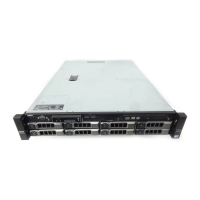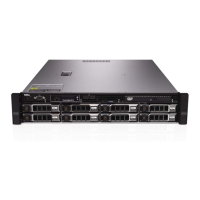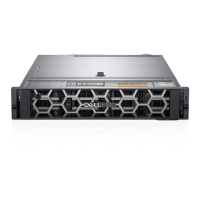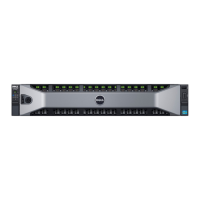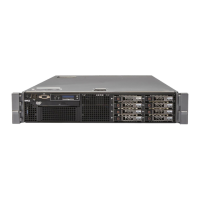Do you have a question about the Dell PowerEdge R530 and is the answer not in the manual?
Details the components and access points on the front of the server.
Explains system status indicators on the front panel during startup.
Provides physical dimensions of the system, including width, height, and depth.
Details the specifications for AC and DC power supply units supported by the system.
Outlines the system's memory capacity, type, and bus frequencies.
Lists operating temperature, humidity, vibration, and altitude limits for the system.
Step-by-step guide for unpacking and setting up the server.
Information on configuring the Integrated Dell Remote Access Controller (iDRAC) settings.
Explains different methods for obtaining system firmware and device drivers.
Guide to accessing and using the System Setup utility for BIOS and iDRAC configuration.
Overview of the Dell Lifecycle Controller for system deployment and management.
Provides essential safety precautions before performing hardware procedures.
Detailed steps for safely removing memory modules from the system.
Instructions for removing hot-swappable hard drives or SSDs from the system.
Procedure for safely removing a processor from its socket.
Detailed steps for installing a new processor into the system socket.
Instructions for safely removing the main system board from the chassis.
Addresses issues where the system stops responding during boot.
Steps to diagnose and resolve problems with USB devices.
Guidance for diagnosing and resolving system memory issues.
Procedures for diagnosing and fixing hard drive related problems.
Steps to diagnose and resolve issues related to system processors.
Introduction to the ePSA diagnostics for hardware assessment.
Steps to launch diagnostics from the Boot Manager menu.
Details the function and configuration of system board jumpers.
Procedure to clear system and setup passwords using a jumper.
Information on how to obtain technical support and service from Dell.
Guide to using the Quick Resource Locator for system information and videos.
Details the components and access points on the front of the server.
Explains system status indicators on the front panel during startup.
Provides physical dimensions of the system, including width, height, and depth.
Details the specifications for AC and DC power supply units supported by the system.
Outlines the system's memory capacity, type, and bus frequencies.
Lists operating temperature, humidity, vibration, and altitude limits for the system.
Step-by-step guide for unpacking and setting up the server.
Information on configuring the Integrated Dell Remote Access Controller (iDRAC) settings.
Explains different methods for obtaining system firmware and device drivers.
Guide to accessing and using the System Setup utility for BIOS and iDRAC configuration.
Overview of the Dell Lifecycle Controller for system deployment and management.
Provides essential safety precautions before performing hardware procedures.
Detailed steps for safely removing memory modules from the system.
Instructions for removing hot-swappable hard drives or SSDs from the system.
Procedure for safely removing a processor from its socket.
Detailed steps for installing a new processor into the system socket.
Instructions for safely removing the main system board from the chassis.
Addresses issues where the system stops responding during boot.
Steps to diagnose and resolve problems with USB devices.
Guidance for diagnosing and resolving system memory issues.
Procedures for diagnosing and fixing hard drive related problems.
Steps to diagnose and resolve issues related to system processors.
Introduction to the ePSA diagnostics for hardware assessment.
Steps to launch diagnostics from the Boot Manager menu.
Details the function and configuration of system board jumpers.
Procedure to clear system and setup passwords using a jumper.
Information on how to obtain technical support and service from Dell.
Guide to using the Quick Resource Locator for system information and videos.
| Dell E-Value Code | PER530_EL0001A_Q4FY17_FG0002_BTP |
|---|---|
| HDD speed | 7200 RPM |
| RAID levels | 0, 1, 5, 10, 50 |
| HDD interface | Serial ATA III |
| Hot-Plug support | Yes |
| Optical drive type | DVD±RW |
| Supported HDD sizes | 3.5 \ |
| Total storage capacity | 1000 GB |
| Maximum storage capacity | - TB |
| Number of HDDs installed | 1 |
| Number of HDDs supported | 8 |
| Supported storage drive interfaces | SAS, Serial ATA III |
| Tcase | 73 °C |
| Bus type | QPI |
| Stepping | R0 |
| Scalability | 2S |
| Processor code | SR2P0 |
| Processor cache | 15 MB |
| Processor cores | 6 |
| Processor model | E5-2603V4 |
| System bus rate | 6.4 GT/s |
| Processor series | Intel Xeon E5-2600 v4 |
| Processor socket | LGA 2011-v3 |
| Processor codename | Broadwell |
| Motherboard chipset | Intel C610 |
| Processor frequency | 1.7 GHz |
| Processor cache type | Smart Cache |
| Processor lithography | 14 nm |
| Processor manufacturer | Intel |
| Processor package size | 45 x 52.5 mm |
| Processor operating modes | 64-bit |
| Embedded options available | No |
| Supported instruction sets | AVX 2.0 |
| Thermal Design Power (TDP) | 85 W |
| Compatible processor series | Intel® Xeon® |
| Supported processor sockets | LGA 2011-v3 (Socket R) |
| Maximum number of SMP processors | 2 |
| Maximum number of PCI Express lanes | 40 |
| Memory types supported by processor | DDR4-SDRAM |
| Memory channels supported by processor | Quad |
| Memory clock speeds supported by processor | 1600, 1866 MHz |
| Memory bandwidth supported by processor (max) | 59.7 GB/s |
| Maximum internal memory supported by processor | 1536 GB |
| Performance management | Dell OpenManage |
| Trusted Platform Module (TPM) version | 1.2 |
| Operating system installed | - |
| Compatible operating systems | Windows Server 2008 SP2 (x86/x64) Windows Server 2012 SP2 (x86/x64) Windows Server 2008 R2 (x64) Windows Server 2012 R2 (x64) Novell SUSE Linux Enterprise Server Red Hat Enterprise Linux VMware vSphere |
| Memory slots | 12x DIMM |
| Internal memory | 8 GB |
| Memory clock speed | 2400 MHz |
| Maximum internal memory | 384 GB |
| Memory layout (slots x size) | 1 x 8 GB |
| Power supply | 495 W |
| Power supply input frequency | 50 - 60 Hz |
| Chassis type | Rack (2U) |
| Cabling technology | 10/100/1000Base-T(X) |
| Ethernet interface type | Gigabit Ethernet |
| USB 2.0 ports quantity | 3 |
| Ethernet LAN (RJ-45) ports | 4 |
| PCI Express slots version | 3.0 |
| Operating altitude | 0 - 3048 m |
| Non-operating altitude | 0 - 12000 m |
| Storage temperature (T-T) | -40 - 65 °C |
| Operating temperature (T-T) | 10 - 35 °C |
| Storage relative humidity (H-H) | 5 - 95 % |
| Operating relative humidity (H-H) | 10 - 80 % |
| Processor ARK ID | 92993 |
| Intel Secure Key Technology version | 1.00 |
| Intel Identity Protection Technology version | 0.00 |
| Depth | 668 mm |
|---|---|
| Width | 482.4 mm |
| Height | 86.8 mm |
| Weight | 28200 g |
